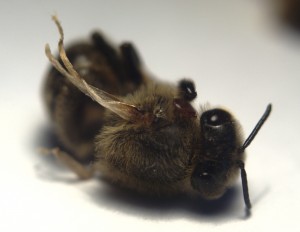THURSDAY, 7 JANUARY 2016
In 2012, a team lead by Professor Declan C. Schroeder from the University of Plymouth reported that the arrival of ectoparasitic mite, Varroa destructor, in uninfected bee colonies resulted in colony decline and loss of virus diversity in Hawaii. They particularly observed that a highly virulent variant (type A) of deformed wing virus (DFV) replaced potentially harmless types of DFV and other viruses present before the mite invasion. These observations raised the question of whether virus exclusion could play a role in managing and reducing the decline in honey bee populations. Competition among viruses might provide protection to the Swindon colonies
Competition among viruses might provide protection to the Swindon coloniesDOI: 10.1038/ismej.2015.186
Written by Anaid Diaz
Image: By Stefan de Konink (Own work) [CC0], via Wikimedia Commons
